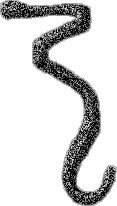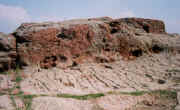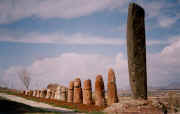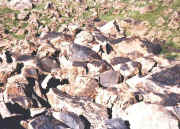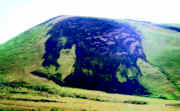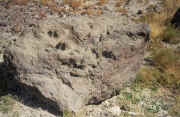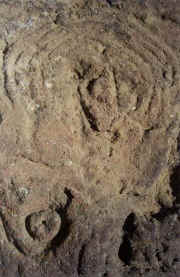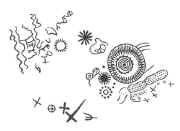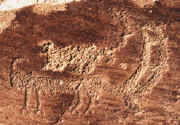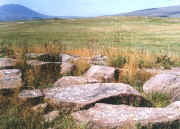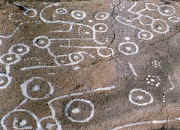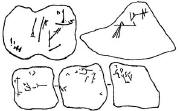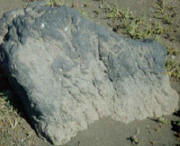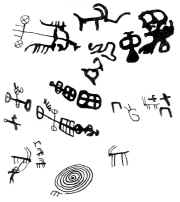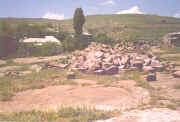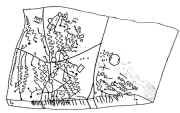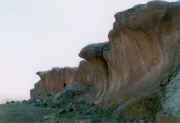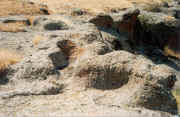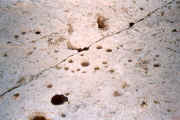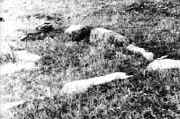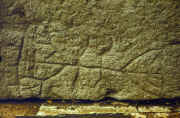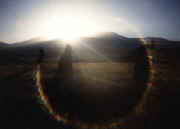|
|
|
|
||||
|
Metsamor settlement, metallurgical center, observatory and carved map Located in Armavir Marz, near Ejmiatsin, by the Sev Jour River.
The site is a Bronze Age settlement and metallurgical center of 3rd - 1st Millennia BC, observatory of 2nd - 1st Millennia BC, an earliest center of worship. The first discovered (1902) rock-carving of Armenia is located here, representing a water-grid map of Aragats Mountain irrigation system of pre-Urartian period (the picture above and the middle picture representing the plan of the water-grid). 16 phalluses unearthed from different parts of this site are now set up in a line: the vishap (stone-dragon) on the right, phalluses on the left (the picture below).
The carvings were noticed in 1902 (Mesrovb Ter-Movsessyan).
Distance from Yerevan: 35 km
|
||||
|
Aragats Petroglyph site and vishaps Located in Aragatsotn Marz.
The highest peak in the Republic is the Aragats mountain (4090 m). The slopes of the mountain are covered
with traces of civilization. There are many fortresses, vishaps, rock-carvings, irrigation systems of pre-Urartian period.
Distance from Yerevan: 55 km Altitude: 2300 - 2500 m |
||||
|
Located in Kotayk and Gegharkounik Marzes.
The Rock-Art sites in Geghama Petroglyph Area offer us to learn and to view the past of Armenians, the native people of the Armenian Highlands.
There are many interesting archaeological sites here:
a/
b/ Fortress-observatory Astghaberd (Star fortress), on the
c/ Vishaps, cromlechs and other megaliths.
One may see 1000-1500 rock-carvings in following sites:
The carvings were discovered in
Distance from Yerevan: 50 km Altitude: 2500 - 3100 m
|
||||
|
Armavir pictograms and sculptures Located in Armavir Marz, near Armavir village.
The picture above represents a stone model of a sanctuary. On the surface of the huge rock-piece there are two well-preserved sculptures (7-8 cm high) which remind five-sided temples or ziggurats. The picture below represents a detail of the monument: a solar-faced creature with quintuple halo on the right of the composition and some carved pictograms.
The carvings were noticed in September 30, 2001 (Karen Tokhatyan, Artak Movsissyan, Hamlet Martirossyan). Distance from Yerevan: 55 km Altitude: 900 m
|
||||
|
Sevsar ancient astronomical observatory
Located in Gegharkounik Marz, above Geghovit village, not far from
The complex were discovered in 1965 (Suren Petrossyan).
|
||||
|
Shamiram settlement and pictograms Located in Aragatsotn Marz, near Shamiram village.
The carvings were discovered in 1969. Distance from Yerevan: 55 km Altitude: 1200 m. |
||||
|
Located in Syunik Marz, on the slopes of Tsghuk (3584 m) and Ukhtasar (3169 m) Mountains.
The carvings were discovered in 1966 (Grigor Karakhanyan, Pavel Safyan). Distance from Yerevan: 240 km Altitude: 3000 - 3300 m |
||||
|
The carvings were discovered in 1966 Altitude: 2400 m |
||||
|
Located in Aragatsotn Marz, near Qouchak
village,
About 60 carved pictograms, mainly geometric symbols, probably letter-like linear script, from the Iron Age (2nd - 1st Millennia BC) may be seen here. 50 of them are under the water for 8 months a year (November - June). Nearby are the ruins of three cyclopean fortresses, Iron Age settlements, and vast burial fields.
The carvings were discovered in 1967 (Suren Petrossyan). Distance from Yerevan: 45 km Altitude: 1850 m
|
||||
|
Located in Syunik Marz, on the slopes of the second peak of RA - Kaputjugh (3904 m), near Mesropavan village (by the name of the creator of the Armenian alphabet - Mesrop Mashtots, 360-440 AD, a great illuminator and pioneer of a new culture).
The study of
pre-Mashtots writing symbols and Mesropian letter-forms are of capital
importance for Armenology. There are number of written testimonies
proving the existence of writing in Armenia before Mashtots.
The rock-carvings were discovered in 1968. Distance from Yerevan: 350 km Altitude: 2800 - 3300 m |
||||
|
Located in the Aragatsotn Marz, near the village of Kakavadzor.
The picture below represents the carved map of the irrigation system. The site is in danger because of the newly constructed dwellings not far from it.
The carving were noticed before 1973 (Koryun Mkrtchyan). Distance from Yerevan: 65 km Altitude: 1700 m |
||||
|
Located in Qarvachar Region of Artsakh, on the slopes of Erakatar and Toli Mounts, on the banks of the Al, Sev and Zalkh lakes. One of the numerous Rock-Art sites in this petroglyph area.
The rock-carvings were noticed before 1981.
Altitude: 3000 - 3300 m |
||||
|
Agarak Sanctuaries and carved stellar maps Located in Aragatsotn Marz, between Agarak and Voskehat villages.
Numerous holes, hollows, and deep furrows linking them, possibly have had metallurgical function (as it is in Metsamor). Some of the hole groups might had astronomical meaning. Beginning from 2001 excavations are held in the site by the Institute of Archaeology and Ethnography of National Academy of Sciences of RA. The results of the excavations prove that the area had been populated at least since 4th Millennium BC, up to Late Middle Ages.
The carvings were noticed in 1989 (Margarit Hovhannissyan). Distance from Yerevan: 30 km Altitude: 1000 m |
||||
|
Located in Kotayk Marz, near Balahovit village.
are similar to Metsamor and Kakavadzor analogous carvings.
Distance from Yerevan: 15 km Altitude: 1200 m
|
||||
|
Located in Lori Marz, near Stepanavan, by Koghes village.
The carvings were discovered in 1990 (Hakob Tonakanyan). Distance from Yerevan: 160 km Altitude: 1500-1600 m
|
||||
|
Located in Aragatsotn Marz, near Voskehat village.
About 130 rock carvings may be counted here dating back to 4th - 2nd Millennia BC... The rock-carvings are on the eastern slope of Lusakatar mountain. Eight expeditions during 1997-2003 revealed, mapped and photographed hundreds of images, located between Agarak and Aghavnatoun villages. Nearby are Early Bronze Age settlements and cromlechs which help to date the Rock-Art site. Two km to the North the Agarak sanctuary is situated. The discovery of this site is very important because it has miraculously survived on such a crossroad of numerous conquests, in Ararat Plain. The site is also unique by its low (in comparison with others) position from the sea level.
The carvings were discovered in 1990 (Karen Tokhatyan). Distance from Yerevan: 25 km Altitude: 1050 - 1200 m |
||||
|
Located in Kotayk Marz, near Geghard village.
Anthropomorphic linear pictograms are carved on the eastern side of the big stone inside the arch gate of Geghard monastery (4th c. AD).
The carving were noticed in 1991 (Hakob Tonakanyan). Distance from Yerevan: 30 km
Altitude: 1200 m |
||||
|
Qarahounge ancient astronomical observatory Located in Syunik Marz, near Sisian town.
There are one carved calendar (?) and one goat-like rock carving.
The rock-carvings in Qarahounge were discovered in 2000 (Karen Tokhatyan, Artak Sargsyan). Distance from Yerevan: 220 km Altitude: 1780 m |
|
©ARARA-T Contact Webmaster |



